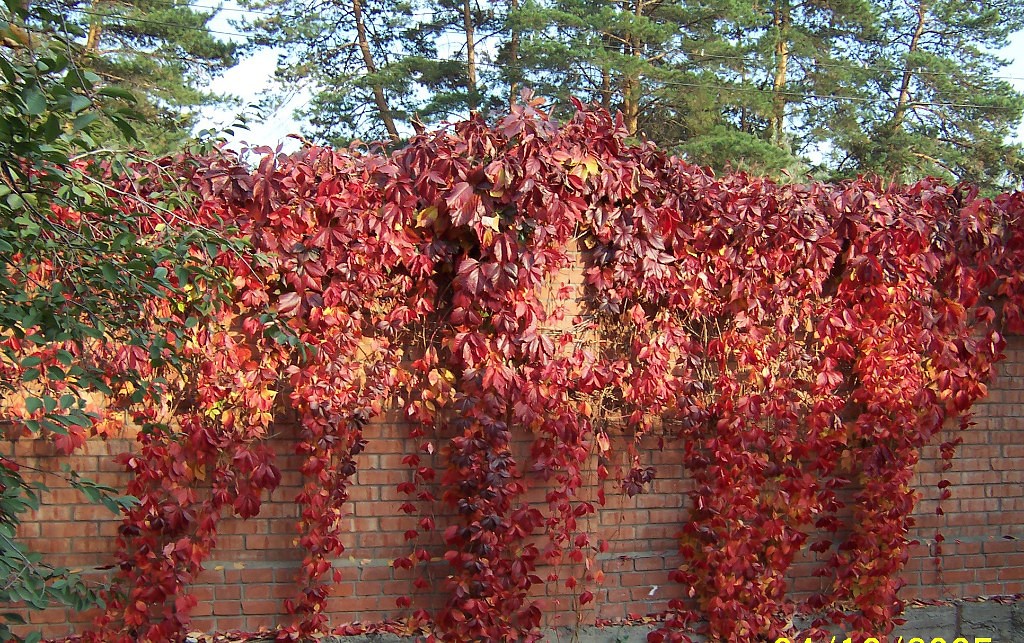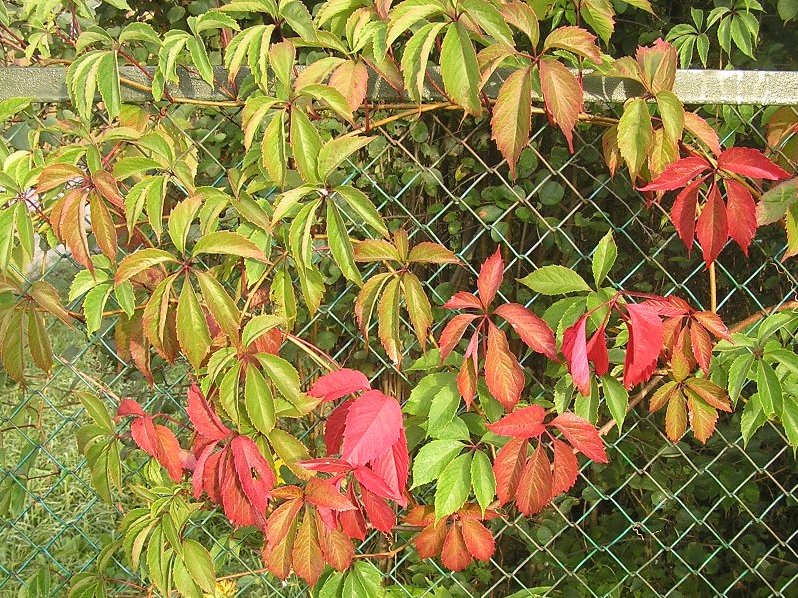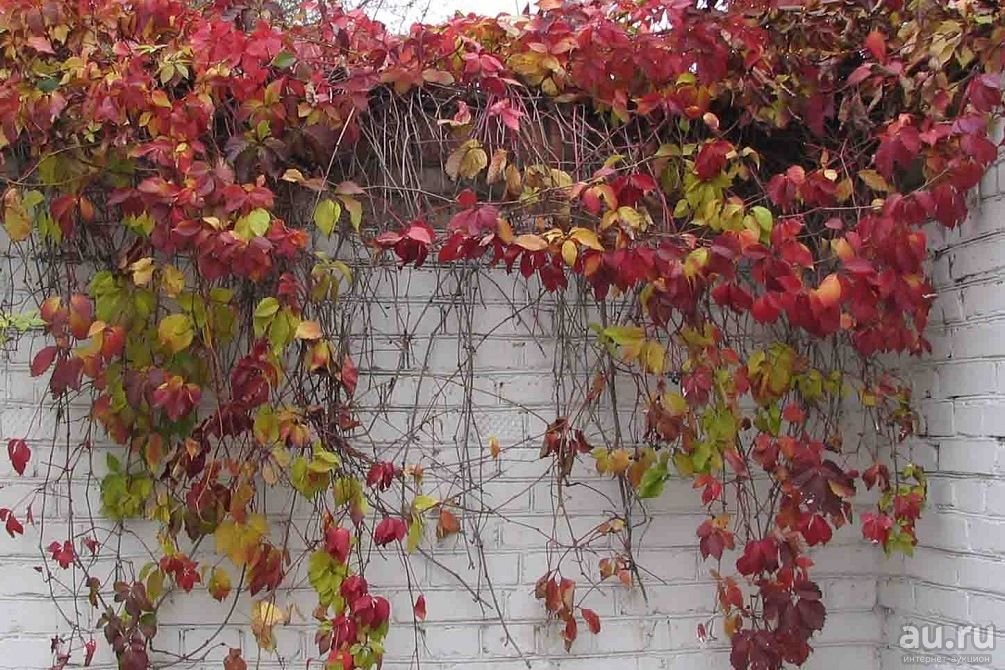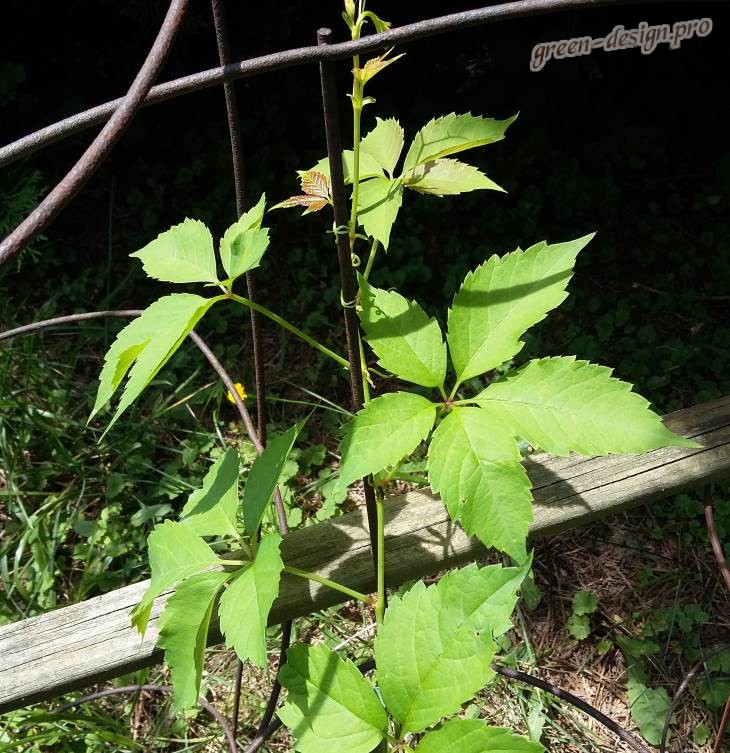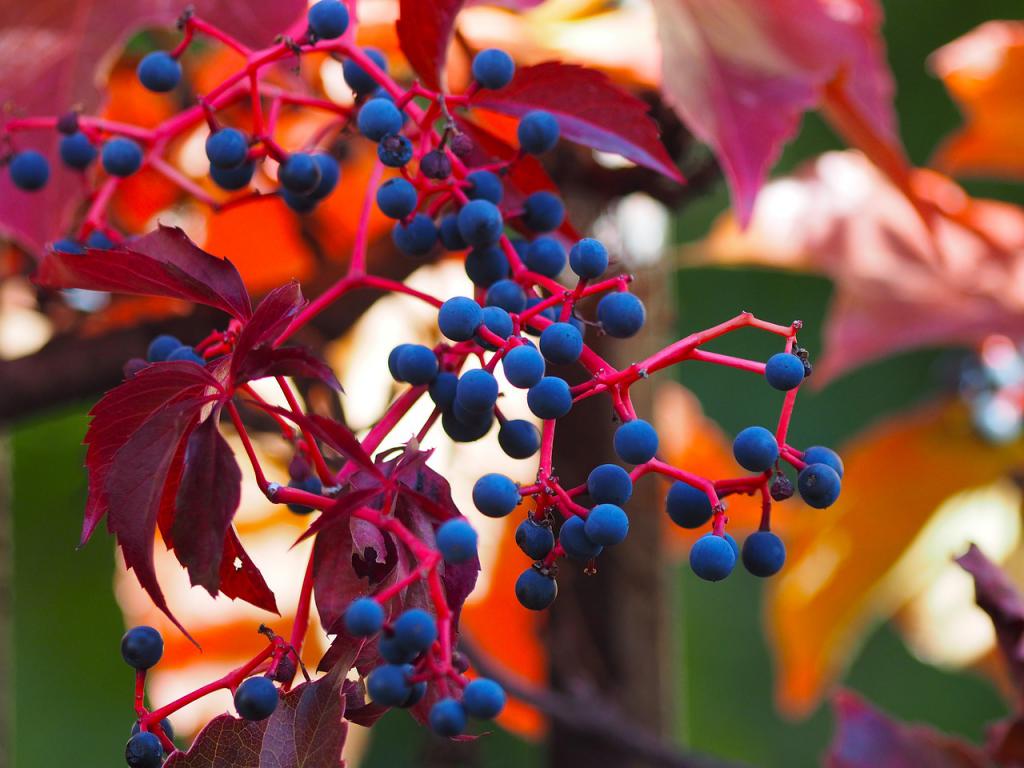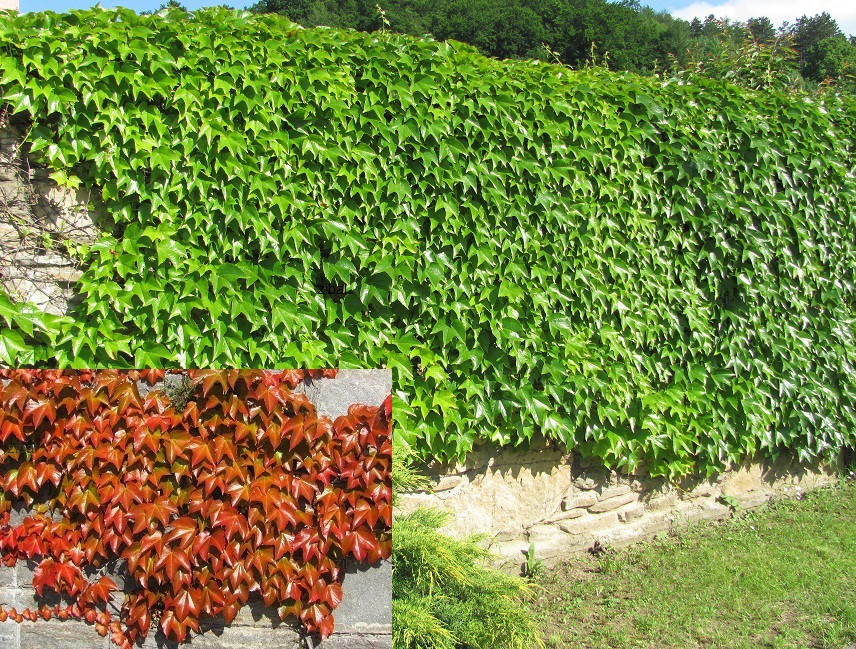Most popular varieties
The maiden grape is a tree-like, deciduous liana. Under natural conditions, it is found in the central part of North America and Asia, namely in the southeast of Canada, in the center and east of the United States, in the eastern part of Mexico, in the east of Russia in Korea, China. But as an ornamental crop, it is grown all over the world.

In autumn, the girlish grapes change color to crimson, which looks very beautiful
Leaves cut into 3-5 leaves. They are petiolate, ovoid, attached to a single, central petiole. The upper part of the leaflet is pointed, the edging is serrated. The color of the front part of the leaf is green, and the back is blue-green, with slight pubescence. In the fall, it changes to crimson, which looks very beautiful.
Flowers appear at the end of spring. They are small in culture, collected in apical inflorescences, in the form of branched panicles with a central axis. Each inflorescence has about 80-150 greenish buds.
Interesting!
Maiden grapes are used in traditional Chinese medicine to treat various ailments.
The fruits are dark blue, but may appear black from the outside. They are about 6 mm in diameter, ripen by the end of August or in September. They are not edible for humans, but birds eat them with joy.
Check out these articles as well
-
Potash fertilizers and their types
-
Cauliflower dressing
-
Wood ash as fertilizer
-
Rose Cordana
There are two main varieties and approximately 19 varieties of maiden grapes, which are grown universally for ornamental purposes.

Photo of a five-leafed maiden grape
-
Five-leafed maiden grapes are also called virgin grapes. Scourges grow about 20 meters long, maybe more. Leaves with 5 branches. The most famous variety of this type is Engelman. It has wide leaves. The growth of vines per year is 50-100 cm. Five-leafed maiden grapes are highly resistant to frost, grow best in the sun.
Photo of triangular maiden grapes
- Tri-pointed maiden grapes are common in Asia. Liana grows to a length of about 10 meters. It winds quickly and well and forms a very dense crown. Almost all varieties of this species are easily propagated by seeds. The famous variety is Vicha. The first year it grows slowly, then the growth per year is 2 meters.
You can buy cuttings or seeds of maiden grapes in stores, on the market or on the Internet.
Another name is ivy. The homeland of the plant is Korea, China, Japan. Frost-hardy vines are very attractive. In the autumn, the foliage of the grapes acquires a red, flaming color, there is a variety with maroon leaves. Breeders have bred a golden form, characterized by yellow blotches on a green background.
The most popular variety in this family is the Vicha grape. Its foliage is small and smooth, two or three-lobed, in summer it is dark green, in autumn it is bright orange. The variety takes root well and grows in the southern regions. The roots of this vine are shallow, a young crop can initially be grown in containers or pots. It grows well next to roads, is not afraid of exhaust gases, shelter is required for the winter.
Tri-pointed maiden grapes.
Raspberry wine
The variety of types of maiden grapes with finger, ovoid or oblong leaves allows you to create a variety of compositions on the site.
Of the main types of parthenocissus, landscape designers prefer the North American five-leaf (virgin) and attached maiden grapes, as well as the Asian tri-pointed (ivy).Currently, there are many decorative varieties and garden forms with variegated, brighter foliage of various colors, pubescent shoots, elongated inflorescences, and brighter autumn coloration occurs in sunny places.
Consider some of the varieties and types of maiden grapes, the most popular among landscape designers and ordinary summer residents.
 Viche variety
Viche variety
Root offspring. This is perhaps the easiest way to breed virgin ivy. Where the vine comes into contact with the soil, roots are formed that take root easily. You just need to plant them in a permanent place, without deepening the root collar.
It is good to combine girlish grapes with hops, if the green leaves of regular hops seem too boring, plant an Aureus plant with yellow-green leaves. The green decorative leaves of the maiden grape will favorably emphasize the flowers of the climbing rose and will become a support for it.
 Maiden grapes decorating the gazebo
Maiden grapes decorating the gazebo
Maiden grape care
Maiden grapes are a very unpretentious tree-like liana, in open ground, caring for it is quite simple, it is enough just to regularly and in time to sanitize the lashes and water in a severe drought. Without pruning, this beautiful plant can turn into ugly thickets.
The most important thing is to carry out the formation of culture on time
It is not necessary to cover the plant for the winter, since frost-resistant varieties prevail in our latitudes, but even if the whips freeze, then there is nothing wrong - new young shoots will emerge from the replacement buds. It is enough just to cut the lashes to healthy wood.
For the first few years, the vine is actively increasing the root mass; during this period, fertilizing with fertilizers is required twice during the growing season. You also need to tie up a young plant, in the future it will find support by itself, clinging to antennae and aerial roots for any roughness on the surface.
Fortified virgin ivy will give an annual growth of several meters. So that the vine does not entangle the entire area, let's figure out how to carry out the formation.
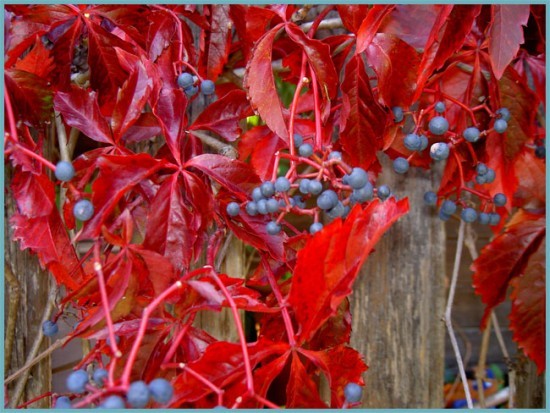 For girlish grapes, you definitely need a support
For girlish grapes, you definitely need a support
- The growing young shoots need to be guided along the support, thus forming the skeleton of the plant.
- Those shoots that do not grow where you need to do not be afraid to remove immediately. It won't hurt the vine.
- After the skeleton has been formed, only sanitary pruning in the spring and restraining pruning in the summer is carried out. All weak, damaged shoots are removed, as well as those that thicken the plant or give a sloppy appearance.
Advice. When trimming shoots, leave no more than 5 mm above the bud, then you will save yourself from sticking out stumps of lashes, which looks ugly.
Care, watering, feeding
Maiden grapes are a very unpretentious tree-like liana, in open ground, caring for it is quite simple, it is enough just to regularly and in time to sanitize the lashes and water in a severe drought. Without pruning, this beautiful plant can turn into ugly thickets.
The most important thing is to carry out the formation of culture on time
For the first few years, the vine is actively increasing the root mass; during this period, fertilizing with fertilizers is required twice during the growing season. You also need to tie up a young plant, in the future it will find support by itself, clinging to antennae and aerial roots for any roughness on the surface.
Fortified virgin ivy will give an annual growth of several meters. So that the vine does not entangle the entire area, let's figure out how to carry out the formation.
 For girlish grapes, you definitely need a support
For girlish grapes, you definitely need a support
- The growing young shoots need to be guided along the support, thus, we form the skeleton of the plant.
- Those shoots that do not grow where you need to do not be afraid to remove immediately. It won't hurt the vine.
- After the skeleton has been formed, only sanitary pruning in the spring and restraining pruning in the summer is carried out.All weak, damaged shoots are removed, as well as those that thicken the plant or give a sloppy appearance.
Advice. When trimming shoots, leave no more than 5 mm above the bud, then you will save yourself from sticking out stumps of lashes, which looks ugly.

Slugs may appear on five-leafed maiden grapes
- Watering is done frequently during dry periods. The rest of the time, water is needed in moderation - once a week. The root system of the culture is well developed, so it is watered abundantly so that the earth is saturated.
- Weed cleaning and loosening of the soil are carried out as needed, although it should be noted that maiden grapes grow like a weed, so you should not worry too much about the looseness of the earth or weeds.
- Pruning is done several times a year if the plant needs to be formed. If you want the vine to wrap around the building, a garter may be required.
- Fertilizers are applied mainly organic (compost, humus, ash, herbal infusions). It is best to do this in the summer when the plant is suffering from heat, rainy seasons or similar disasters. In the spring, if the vine does not grow at all, 40 g of nitroammofoska can be added to the soil.
- Winter preparation is not required. The culture is resistant to frost, and how to cover the plant that wrapped around the building, for example? But, if there are concerns, you can mulch the root zone with 25 cm of peat and cover the base of the maiden grapes. It'll be enough.
Interesting!
Many vines react negatively to pruning, but not girlish grapes. This culture can not only be cut, but also shaped. This can be done throughout the summer.
Maiden grapes are practically not damaged by diseases and insects. Very rarely, if there are a lot of aphids in the garden, it can settle on this crop. Then you can treat it with "Aktara", "Fufanon", "Tanrek", "Fitoverm".
Girlish grapes are pleasing in appearance. This is a very beautiful crop with rich foliage color. Conifers, climbing roses and flowers like clematis coexist best next to the girl's grapes. It is believed that maiden grapes protect from noise and dust, improve the microclimate on the site. In summer, wrapping around the building, the vine keeps the inside cool and fresh, and during the rainy season it protects it from dampness and cold.
Irrigation for the crop may not be needed, an exception may be a prolonged drought. In case of unfavorable weather, the plant is watered three to four times per season in the morning or evening hours. The watering rate is two buckets for each bush. Once a year, the soil is loosened, weeds are removed, the soil is mulched.
The rhizome of maiden grapes is prone to exposure. If this happens, it is necessary to add fresh soil, and slightly huddle the liana. The procedure is carried out in the fall, during the preparation of the garden area for the winter cold.
During the season, sanitary pruning is carried out, damaged and dry shoots are removed, and those that need to be controlled from overgrowth.
How to plant girlish grapes
One of the names of the plant is "wild grapes", which testifies, in particular, to its unpretentiousness in growing conditions.
The soil
The plant is undemanding to the quality of the soil and is able to grow even in unfavorable conditions. To provide him with the best opportunities for growth, you should choose a fertile soil that is fairly loose, capable of passing and retaining moisture well. Loams with relatively neutral pH values are suitable - in the range from slightly acidic to slightly alkaline.
Correct fit includes the following steps:
- In unsuitable soils, pits or trenches are pre-made with a width and depth of 50-60 cm.
- A drainage layer (broken brick, crushed stone, expanded clay) is laid at the bottom of at least 10-15 cm.
- Fill with a mixture of soil, humus (compost) and sand in an approximate ratio of 2: 2: 1.
- When planting in a container, it is advisable to choose it with a width and depth of at least 30-40 cm, since the plant forms a developed root system.
- After preparing the planting site, the soil is periodically watered for two to three weeks so that the soil settles and compresses.
Landing rules
For better growth of grapes, the following rules are observed:
- The prepared planting material is carefully dug out in order to damage the roots as little as possible.
- At the planned place, small holes are made according to the size of a soil clod with roots. Between adjacent seedlings, an interval of 50 to 100 cm can be maintained, depending on the desired density of the green cover. Even with wide enough intervals, the grapes grow quite densely, forming many shoots.
- The root of the seedling is dipped into the hole, sprinkled with soil and slightly compacted. The root collar is left at ground level or slightly higher. Before planting, to improve root formation, "Epin" or "Kornevin" is introduced into the pits.
- The planted plants are watered. The surface of the earth after watering can be mulched with soil, humus, compost. This will keep moisture retained for longer, allowing for better growth.

Rooted seedling with young shoots
When planting and transplanting grapes, a support for its growth is prepared in advance. Frames and gratings are installed, strong threads and wire are pulled. Plants older than 2 years should not be transplanted, since long shoots are difficult to tear off from the previous support and fill in a new one. Better to plant young seedlings.
Planting methods
You can grow girlish grapes in different ways:
- the plant is rooted by cuttings;
- rooted by root suckers and layering;
- you can sow seeds, but this is a more laborious process.
Planting seeds
A little used method, because often the seeds of the girl's grapes do not have time to ripen. In addition, other planting methods provide fast and complete growth.
Seeds are planted in prepared, loose and flavored soil to a depth of 1 cm. Planting dates are spring (April-May) and autumn (September-October). For spring planting, hardening must be done: soak the seeds for several hours in cold water, place in a damp cloth and keep in the refrigerator for a week.

Sowing grape seeds
Planting cuttings
Rooting cuttings is an easier way than planting seeds. It is used when there is no way to get cuttings or root suckers. Planting can be carried out during the entire warm period, preferably in autumn or spring.
For reproduction, it is better to take lignified stem fragments. Vine shoots are cut into cuttings 25-30 cm long and approximately the thickness of a pencil - so that each has 3-5 full-fledged buds. Then they are buried in soft, loose soil so that two or three buds remain above the surface. After planting, the land is well watered. In the hot season, the rooting area is sprinkled with a mulch layer to retain moisture and kept moist. Seedlings should be protected from bright sunlight.

Preparing cuttings for planting
Layers and root suckers
The most affordable and fastest are root suckers and layering. If the stems of the plant are in contact with the ground, roots will easily form on them. This happens especially easily in young shoots that have not been able to catch on to the support. For transplantation, the stem between the growth site and the maternal root is cut off, a young shoot with roots is dug out together with a lump of earth and transferred to the planned place. The root collar is not buried.

The scheme of propagation of grapes by layering
You can carry out the rooting process artificially - by removing and spreading the liana lianas on the ground. Every 40-50 cm it is sprinkled or dripped in places where there are kidneys. You can fix the shoot with slingshots, hairpins.
Buried stems constantly moisturize. After the formation of the roots, the shoot is cut into pieces and planted in prepared holes or trench.
Planting maiden grapes
Location
 Before planting this culture, you need to determine its location. This plant, as mentioned above, is completely non-capricious and feels good both in the sun and in the shade. There is only one thing that can be affected by the level of light and that is the color of the leaves.
Before planting this culture, you need to determine its location. This plant, as mentioned above, is completely non-capricious and feels good both in the sun and in the shade. There is only one thing that can be affected by the level of light and that is the color of the leaves.
When the plants entwine the southern part of the building and are well illuminated by the rays of the sun, the grapes in the fall will change their color from green to burgundy, orange, red, etc.
If the plant is planted on the north side of the building, then the foliage can be green until the time it flies around in winter. It must be said that in the illuminated areas the liana develops faster, the plant grows well, and the leaves are formed larger.
Soil composition for maiden grapes and planting time
 This plant will perfectly take root in a new place, regardless of whether it is planted in autumn or spring. However, experienced gardeners recommend planting in October or September.
This plant will perfectly take root in a new place, regardless of whether it is planted in autumn or spring. However, experienced gardeners recommend planting in October or September.
Regarding the soil, this plant is just as undemanding to its composition. Grapes thrive in any cultivated land. The planting procedure consists of a number of simple steps:
- A week before planting the plants, you need to dig up the ground and remove all the weeds.
- At the landing site, it is necessary to make a hole about half a meter deep and lay drainage on the bottom, which can be made from pebbles, small stones, broken bricks, etc.
- Pour about 25 cm of sand on top of the drainage layer.
- The next step is to prepare the ground. For this, two parts of garden soil are mixed with one part of sand and two parts of compost.
- The hole is filled with this soil and a grape seedling is dug in.
Features of growing grape seedlings
 In order for the culture to develop faster, it needs to be fed.
In order for the culture to develop faster, it needs to be fed.
It is customary to make bait several times per season, the first time the grapes need to be fertilized in the spring. For which purpose 1 m³ is mixed with 50 grams of nitroammophoska.
When the grapes begin to develop actively, 150-200 grams of "Kemira Universal" bait is introduced into the ground.
With the beginning of autumn, the soil is additionally saturated with potash fertilizers, for which potassium magnesium or wood ash is suitable.
When you want the shoots to develop quickly, then feed the plant with "Aquamarine" at the rate of 50 grams of the preparation per 1 m² of land. We must not forget to remove weeds and at least occasionally loosen the soil around the stems.
Description of the variety
The ornamental grape is a fast growing perennial plant. It is worth noting that the vines of this culture are able to cling to almost any surface and reach up, and its antennae help the plant to gain a foothold on the vertical plane.

Important! Maiden grapes practically do not require maintenance and are able to braid large areas literally in a short period. Maiden grapes are characterized by the following characteristics:
Maiden grapes are characterized by the following characteristics:
- the plant has luxurious foliage;
- if the material is planted in the spring, then the culture will delight with a dark saturated green color throughout the summer;
- if maiden grapes are planted in the fall, the foliage will acquire purple tones;
- during the flowering period, fragrant inflorescences are formed on the culture, attracting insects;
- the fruits of the plant ripen by September, however, they are not edible, but are only decorative;
- this variety has a strong immunity to fungi;
- ornamental variety is resistant to attacks of pests;
- the plant is highly resistant to frost, does not require covering.
As described above, caring for a girl's grape is not difficult. Moreover, this variety has a high survival rate and durability.
Advantages
Maiden triangular grapes can be most often found in summer cottages, due to the fact that this decorative culture has a lot of advantages, namely:
- vines are able to disguise the most unsightly areas in the country;
- this variety is well suited as a decorative wall covering;
- using this culture, you can create a wide variety of forms of hedges;
- the decorative variety most often serves to form living fences;
- girlish grapes on the balcony will protect such a structure from gusty winds and sedimentary phenomena;
- using this plant, you can create a cozy shade in the gazebos;
- this culture is able to protect the room from dust, fungus and improve the microclimate.
It is able to protect the building from strong heat in hot weather. In general, such a culture will delight the eye and help create a small island of freshness in the hottest weather. That is why wild grapes on the balcony are quite common.

Disadvantages of culture
But not only this culture has a lot of advantages. Despite the fact that this variety does not require maintenance and grows well on terraces and balconies, before planting it, it is still worth knowing about certain negative points so that you do not have to get rid of decorative grapes.
So, the disadvantages of culture:
- sprouts are able to penetrate under the roofing material and thereby render it unusable;
- often this culture leads to the destruction of the plaster on the building;
- the root system of grapes can damage the foundation of the structure;
- uncontrolled crop growth can create shadows on windows and clog gutters.
In addition to the above points, it is important for novice gardeners to consider that after the leaves fall, the facade of the building can look very dull. However, if we consider that most of the time of the year ivy still pleases the owners with its beauty, then the last drawback pays off.
If the fence is located a meter from the building, then it is possible to plant wild grapes along the fence, but it is necessary to maintain a distance of 40 cm from the building wall.
Hybrid varieties
Hybrid varieties are created artificially - reproduction with seeds will not give a decorative effect, since the characteristic properties are not preserved. Planting and caring for cuttings of wild maiden grapes in summer is the only way of propagation to obtain a varietal plant.
Starfall
Variegated variety with different color combinations:
red and white;
green-yellow;
green and white.
They try to plant these species in lighted places in order to maintain the brightness of the leaves. In the shade, they turn to their usual green color.

Henry
The variety is originally from China. In the middle lane, it is not common due to its weak frost resistance, but some lovers of house plants grow it at home in a pot, decorating glazed but unheated balconies.

Engelman
Created on the basis of a five-leaf. Differs in the autumn variety of shades in one liana - yellow, red, burgundy and orange. It grows more slowly, the maximum height is 9 m.

Strings
It is also called the Red Wall. It is a type of five-leaf variety. The difference is in the red color of the leaf plates, which persists from spring to autumn.

Grape care
Girlish grapes are not whimsical to care for. It is enough to cut off excess shoots when growing, fix them and direct the lashes in the right direction. In spring, usually dry, rotten shoots are cut off, the soil is equipped with nitrogen fertilizer. In summer, periodically it is necessary to loosen the soil, to prevent its compaction. When exposing the roots of grapes - sprinkle, sprinkling them with earth.
If the summer is hot, then you need to water it more often, but not less than 3-4 times per season. Grapes are frost-hardy, do not require special shelter for the winter. Even with freezing of individual trunks in the spring, dormant buds are restored and begin to grow again.

The grapes need no support.Due to its mustache, it climbs independently on any, even smooth surface, but under the weight of its weight it can fall with strong growth. Therefore, it is better to install a support for it so that it does not spread out on the ground with a carpet in the end.
1. Watering
Grapes are undemanding for watering. In severe drought, watering should be done no more than 3-4 times a year. In regions with regular rains, there is no particular need for watering the grapes.
2. Soil for grapes and fertilizers
The wild liana is distinguished by its rapid growth, is not pretentious to soil and moisture, it grows quite well on any soil, the main thing is that the soil is not too saturated with water, otherwise the roots of the plant will simply begin to rot.
3. Top dressing
In the spring, nitrogen fertilization is usually applied to each plant. It will not be superfluous to feed the vine with nitroammofosk (50 g per square meter of plot) or Kemira-universal (150 grams per 1 square meter of plot). You need to feed the plants often, at least 1 time per week during the period of its active growth, vegetation, which lasts 158 days from May to October.
The grapes begin to bloom in mid-June. At this time, you do not need to fertilize the soil, only water it as needed, preventing the soil from drying out.
Young shoots should be weeded out during the summer season, and the soil should be loosened. Frost-resistant grape varieties tolerate winters: tri-pointed and five-leafed. Annuals can freeze slightly, but with the onset of spring new shoots grow, the plant begins to grow vigorously.
4. Diseases and pests
Grapes do not succumb to fungal diseases and insect eating. Only a slug can harm grapes.
But gardeners know plenty of remedies against such pests:
- Use lemon zest as a slug trap. Cut the fruit in half, separate the flesh from the rind, cut a hole in it, place it next to the plant. The slugs will be attracted by the scent of the grapefruit and once they get inside the hole under the peel, they will enjoy the taste, and you can collect them.
- Pour beer into a can, bury it in the ground, leaving 2-3 cm of the top of the can on a hill so that slugs can easily climb inside. After a week, a decent amount of slugs will collect inside the container. Throw them away, pour in fresh beer, the drink will attract the next batch of grape pests.
5. Transplant
It is not recommended to replant grapes during the period of active branching and release of lashes. You can think about a transplant only 2-3 years after its initial planting, when the lashes have already grown strongly or the hedge needs to be moved to another place.

Having torn off this outlandish plant from the support, you will not be able to see a new encirclement of a hedge or fence soon, and it is difficult to replant 2 meter seedlings. Although they have a good survival rate, old seedling buds quickly begin to grow, and grapes - overgrowth. Transplanting is not terrible for grapes.
The main thing you need to know is that the support is prepared in advance, if you do not intend to frequently replant grapes, and have chosen a permanent place for his residence. To transplant in a new place, you also need to dig holes for seedlings, fill the bottom with drainage, on top - with a layer of humus, lower seedlings or cuttings into the holes, sprinkle with earth, lightly tamp the soil.
Next, form holes for the convenience of watering the seedlings and a sufficient amount of accumulated water in them.
Description of the variety
This species is perennial, tree-like, grows in the form of vines, belongs to the ivy group. Therefore, the girlish grape does not twist, but clings with small tendrils to the surface of objects that are nearby. That is why it can be seen on the walls of houses. The vines of the maiden triangular grapes cannot be detached from the place, since the second time they can no longer attach on their own.
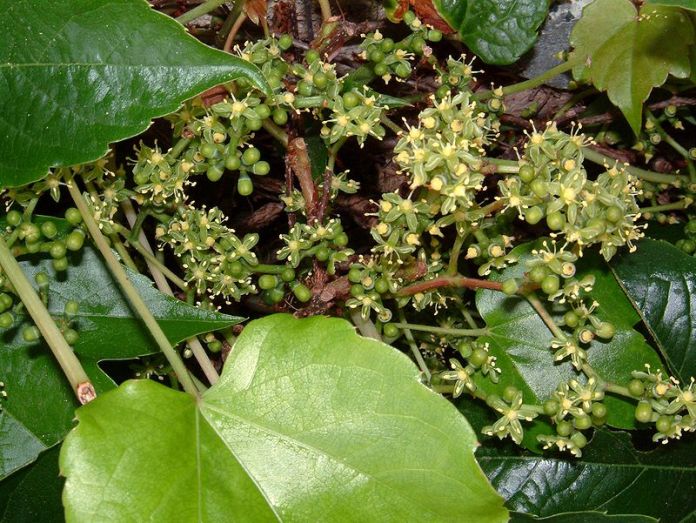
Fruits on the plant are formed without pollination. That is why the species was called maiden (virgin).
The foliage of a maiden triangular grape is large in size, has a tripartite appearance.The leaves are shiny, change their color according to the seasons. In the summer season, the foliage is bright green, and with the onset of autumn, it is repainted in carmine red. Outwardly, the leaves resemble ivy.
The maiden triangular grape, whose vines reach up to 20 meters in length, grow very quickly. In one year, the growth can be from 3 to 5 meters!
Its inflorescences are corymbose. The maiden triangular grapes bloom inconspicuously - the flowers are small, pale in color (green-yellow).
The fruits are small and blue in color. Their surface is waxy. These berries are not eaten. They are used for decorative purposes only! Fruit weight is about 7 grams
Few people pay attention to the fruits, because the main decoration of triangular grapes is its luxurious foliage.







